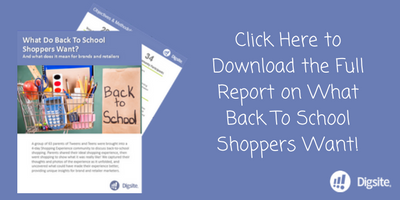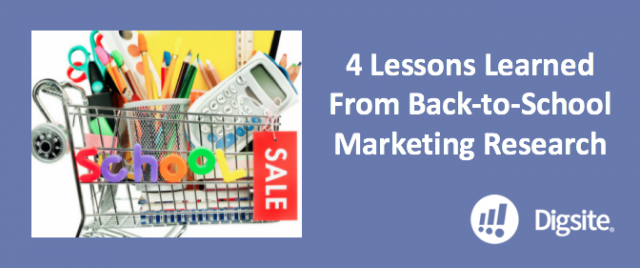
Back-to-school shopping isn’t just about price and coupons -- it’s an important time for family bonding. New back-to-school marketing research reveals why and how retailers can leverage this annual event as a memorable family experience.
Quantitative research can reveal many things about consumer shopping. But to understand how parents approach back-to-school shopping season, we decided to dig deeper. Using Digsite Sprints, we conducted a qualitative study and uncovered some eye-opening insights.
While price and promos are important, it’s the bonding that has transformed the search for school supplies into a time-honored family tradition. Retailers can learn from the study’s insights to create a memorable shopper experience, making their store a “must-go” in the customer’s annual trip.
Quantitative Research Shows Evolving Shopping Habits
There has been an extensive amount of quantitative research to study shopping habits. Some highlights from recent studies show some of the changing habits of consumers:
-
49 percent of Americans tried “click and collect” (shop online, in-store pick-up), according to a survey by CNBC, conducted by market research company InfoScout (@infoscout).
-
Consumers are using mobile point-of-sale systems to purchase. Verifone (@verifone) notes that 75 percent of consumers won’t wait more than five minutes in a queue, and merchants are accepting more payments via mobile point-of-sale systems, as purchases of these devices by retailers increased 107 percent worldwide in 2015, according to Datacap Systems (@datacapsystems).
-
Omnichannel mobile payment options are increasingly important. Paypal, for example, is the third more preferred payment option, behind Visa and Mastercard, and it is especially important among millennials, according to a study by Connexity (@connexity).
These are interesting quantitative trends, but what happens when parents actually engage in back-to-school shopping? To dig a little deeper, we turned to online qualitative research.
A Unique Qualitative Research Tool for Revelatory Insights
First, a little background on the research tool that generated the findings -- Digsite Sprints.
A Digsite Sprint is an on-demand market research study designed to get in-depth insights with a highly targeted audience over a period of a week or less.
This online qualitative research tool includes an interface that resembles familiar social media.
It provides us with the opportunity to survey parents, then interact and respond to their feedback. (You’ll see an example later in the “Follow-Up Activity.”)
For this study, 29 parents of teens and 34 parents of tweens were recruited via social media based on their attitudes, interests and behaviors. We’ll share the key takeaways throughout this post, but you can download a complete report on the study by clicking here.
Activity 1 - Defining the Ideal Back-to-School Shopping Experience
Throughout the study, parents engaged in a series of 4 activities, completing 11 tasks. In the first activity, the group was asked to share their back-to-school shopping habits through a survey. This was followed by an online discussion in which they shared their “ideal” experience.
The survey revealed that the ideal time to start shopping for back-to-school items was a few weeks before school. That’s consistent with a survey conducted by Zulily (@zulily) and reported in Parenting (@parenting), which found that 24 percent of parents start their shopping in July and 26 percent in August.
Here is the result of the tweens parents’ survey, which trended the same as the teens.
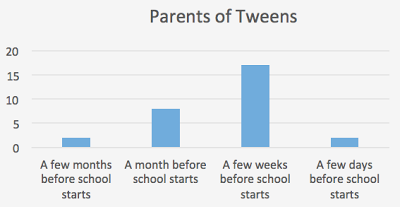
While finding the best price is important to parents, the qualitative responses indicated that back-to-school shopping is a time for parents to bond with their children. It comprised a big part of the ideal shopping experience:
“Ideally, we find everything we need in one spot with good options...If we can get everything we need I feel accomplished and nostalgic. I loved shopping for supplies as a kid.” - Eliza, Tween Parent
_0.png)
“Store is clean, well lit but not blinding. I prefer to shop in person, to try items on.” - Stephanie, Teen Parent
Key Takeaway #1: An Organized Store Facilitates Family Bonding
The in-person experience was very important for families. Many parents expressed fond memories of back-to-school shopping as kids, and wanted to enjoy it with their own children.
Retailers should remove as many potential stress-inducing elements as possible to allow that bonding to occur. That requires a well-organized store, and clear communication on pricing and promotions.
To see the results of Activity 1, including other Key Takeaways, click here to download the report.
Activity 2 - Influencers on Shopping Behavior: Does Price Really Make a Difference?
While the bonding experience is important to parents, pricing and promotions are still extremely important. We found many parents focused on price and promos, such as BOGO, money and percent off deals.
When asked about what stores and websites need to provide so parents will shop with them, price and promos seem to be a retailer’s proverbial “foot in the door.”
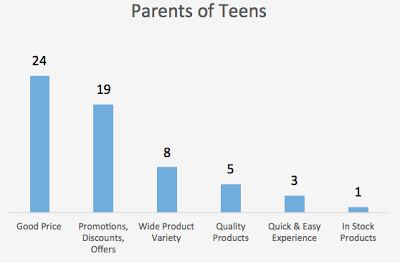
Apps are becoming a bigger part of the screening experience, mainly for comparison shopping. This is consistent with research done by Rubicon (@rubiconproject), as noted on this post on Retail Dive (@retaildive): “71% of parents plan to use retailer apps before they make a purchase, 66% use mobile apps to compare prices, and 64% use them to search out sales.”
Parents wanted a streamlined shopping experience, with access to deals via their smart phones. Email promos were regarded by some as “noise.”
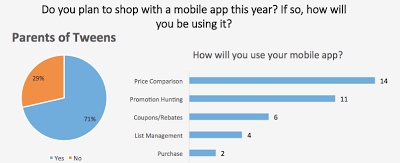
Key Takeaway #2: Apps are Used In-Store, Not for Online Purchases
Parents used apps and coupons, but predominantly in-store. Apps and email promos should be used more to enhance the in-person experience, and less to drive online sales. Print Coupons were regarded important only if the deals were too good to pass up. Digital promos were the primary form of redemption post-purchase; some parents even called for digital coupons.
To see the results of Activity 2, including other Key Takeaways, click here to download the report.
Activity 3 - Revealing the Live Shopping Experience
In the next Digsite activity, participants were asked to go shopping and record their experience. Both during and after the trip, participants took photos and made notes, eventually contributing written comments through the Digsite interface. Here are a few verbatim examples:
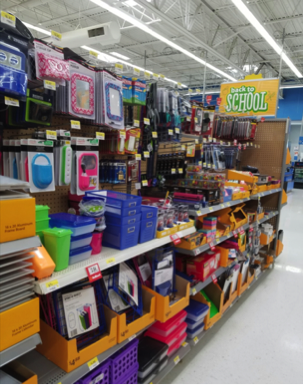
“I really like how walmart had the large back to school dept set up it was well organized writing instruments, markers, crayons etc...then notebooks,folders and organizers in one area also all the non-essentials as well in one convenient area” - Emily
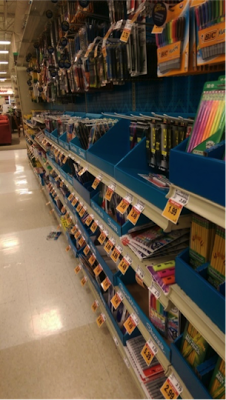
“I typically hit this one store called Fred Meyer because it has everything, and I can get all I need in one spot. Everything went well. Because there were several color options. Nice and organized lots of options, and prices clearly marked!” - Hazel
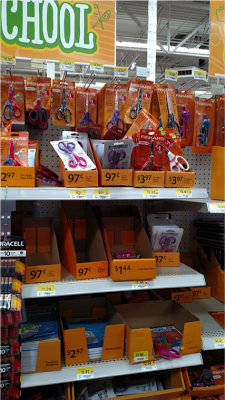
“The hardest part was getting the correct details from the teachers. I did find that there were more supplies left then I expected. I found the unorganized and multi location of stuff frustrating.” - Meg
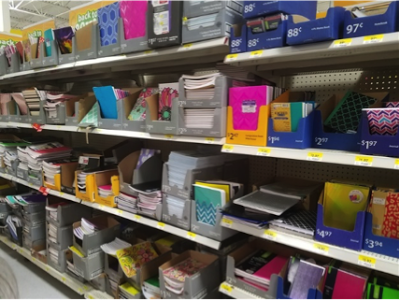
“This to me is exactly unorganized. Folders, composition books, filler paper and spiral bound notebooks are all in one aisle, yes. But the stacks make it difficult to pick through. The prices are completely scattered about and inconsistent.” - Susan
Key Takeaway #3: In-Store Requires So Much More
A well-organized store with clear communication includes more than just clear aisles and neatly labeled bins. It requires store employees, ready and willing to answer questions.
Having employees available could be a way to differentiate the entire experience from that of the competition. Think of how much emphasis The Ritz-Carlton puts on service -- could the same concept be applied to back-to-school shopping?
One participant even joked there should be wine at the dressing rooms -- at least, we think she was joking...
To see the results of Activity 3, including other Key Takeaways, click here to download the report.
Special Follow-Up Activity: Clarifying the “Organized Store”
Digsite is an interactive forum that takes place over a series of days (or even weeks). One of the benefits from the time duration is that marketers can listen to feedback, and then respond with either adjusted product ideas, or in this case, probe for more details.
When it became clear that a well-organized store was extremely important, Digsite researchers asked the participants to define what “organized” includes. Some of the verbatim comments and photos include:
“Organized means that things aren’t mixed together in bins, that pens and pencils are together, folders and paper, etc. More categorized by item not by brand, etc. The biggest part though is the not mixed together bins and crates - drives me crazy!” - Cameron, Tween Parent
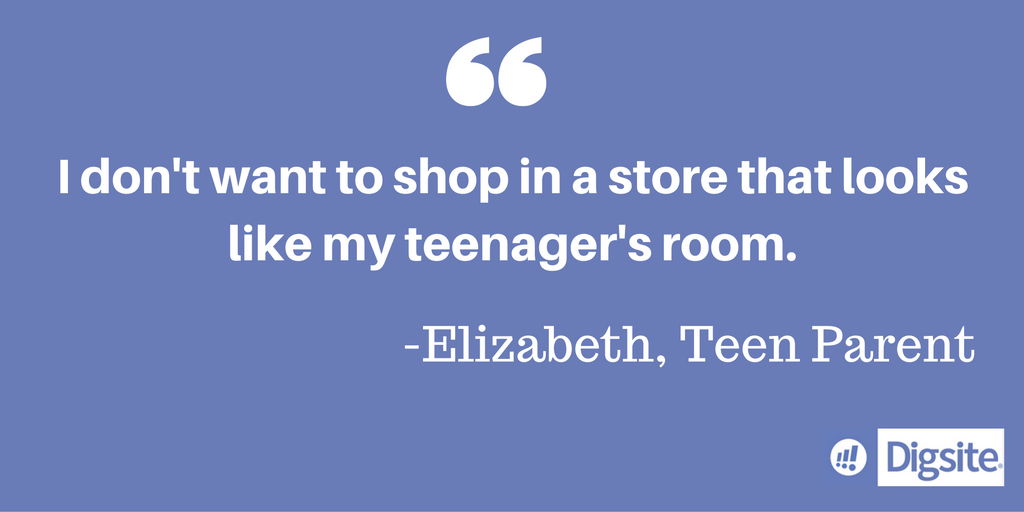
“Needs to have aisles clean where carts can move freely without stuff being on the floor. Shelves should look tidy. I don’t want to shop in a store that looks like my teenager’s room” - Elizabeth, Teen Parent
Activity 4 - How to Improve the Experience
In the final activity, participants were asked to complete a survey on how their overall experience could have been improved. They responded to open-ended questions, which allowed them to share emotional reactions and feelings.
Allowing participants the chance to express their emotions helped further define their preferred experience and gave them the opportunity to provide nuanced examples of what they wanted.
They also provided ideas on promotional approaches. For example, some parents said it would be nice to have “bundles” ready for them based on the shopping lists issued by the schools. These comments provide insights on what retailers can build for their customers.
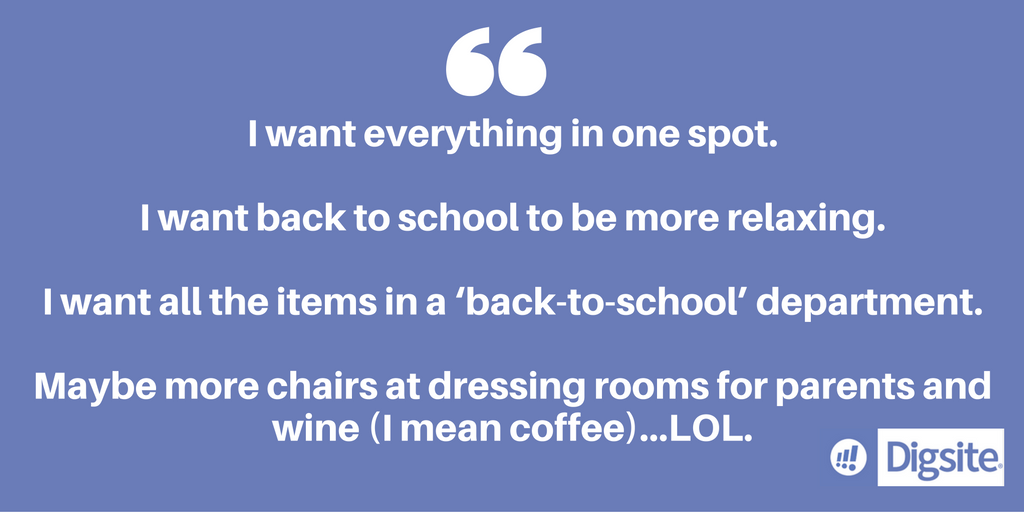
Key Takeaway #4: Less About Numbers, More About People
It stands to reason that because so many parents prefer the in-store experience to online shopping that they would also want the entire shopping experience to be more personalized. Participants did not want to be treated like a “number.” In-person means personal.
To see the results of Activity 4, including other Key Takeaways, click here to download the report.
Back-to-School Shopping Not Just About New Clothes and Office Supplies
Qualitative research does more than show you what types of items consumers want to purchase. It also explains why they purchase -- in a manner that can only be revealed through conversation and interaction.
This research revealed that back-to-school shopping has become a family tradition. And like all family traditions, it invokes emotional, personal responses. You can gear your marketing to that level of response.
Marketing is always looking to make a connection - to personalize a brand as much as possible.
You can make the connection with customers in a unique way, and use these Digsite insights to create an experience that will last long past the checkout register.

